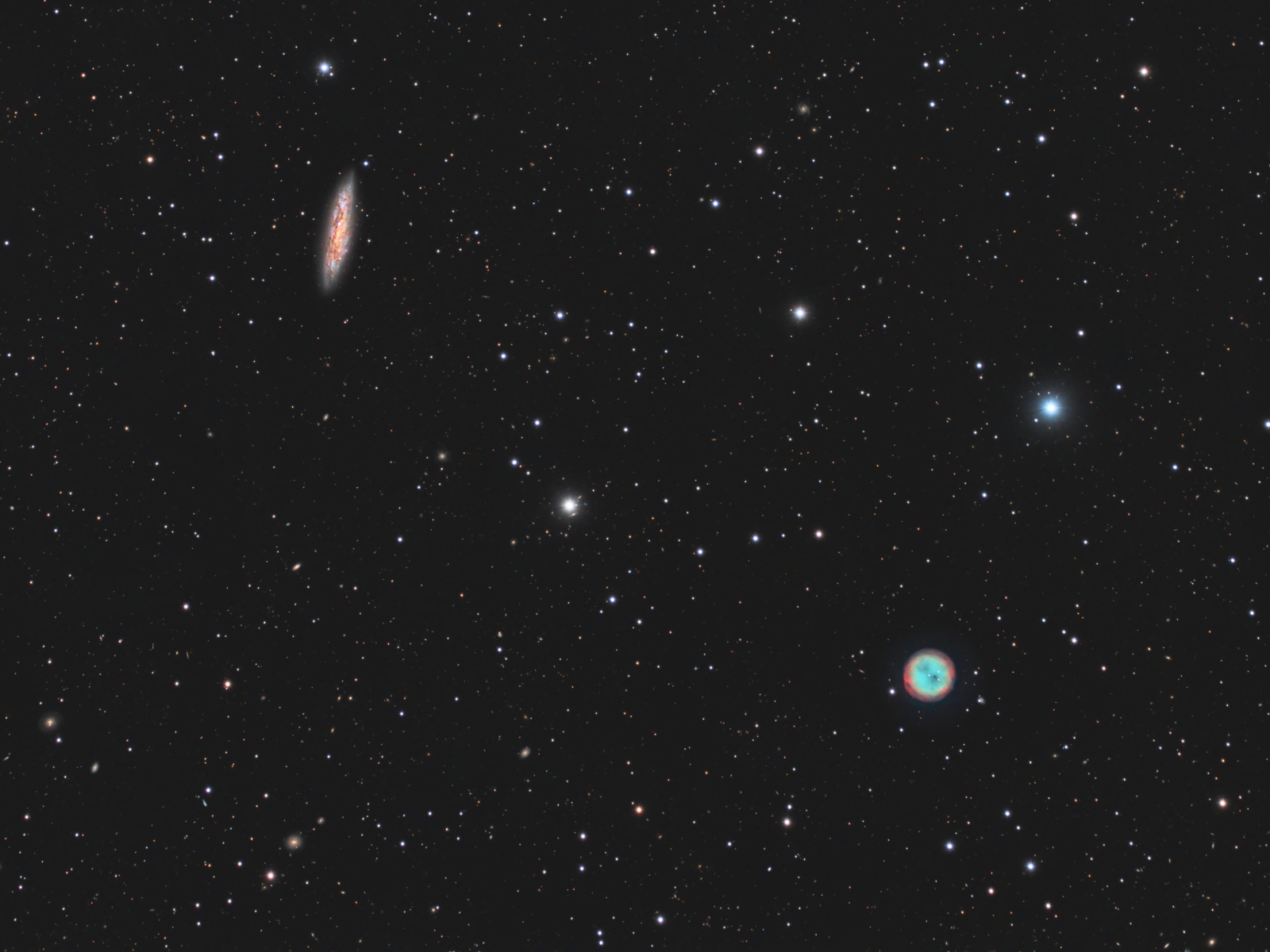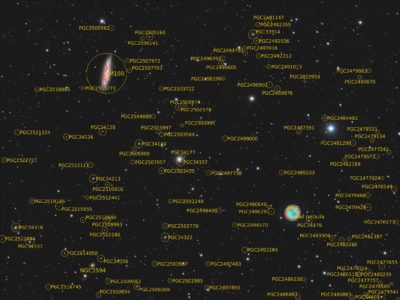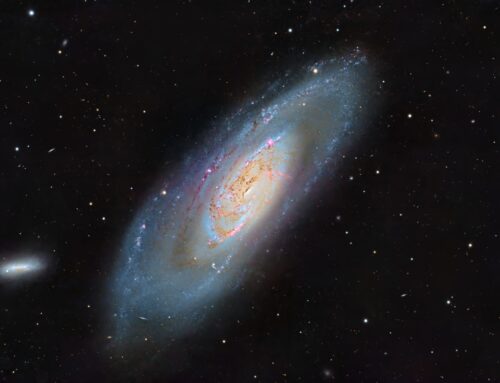M97 and M108
 Click image for full size version
Click image for full size version
April 30, 2020
M108 (upper left) and M97 (lower right) are the main subjects of this picture. This field lies in Ursa Major, near Merak, the lower-right star of the Big Dipper’s bowl.
M108 lies about 46 million light years away and belongs to the Ursa Major galaxy cluster, which in turn is a member of the Virgo Supercluster of galaxies. This very active galaxy displays the full range of colours found in some spiral galaxies, including pink nebula, blue star clusters, a yellow/orange core and many dark brown dust lanes throughout. The super-massive black hole at the centre of M108 has a mass about 24 million times the Sun’s.
Compared to M108, the Owl Nebula is just a stone’s throw away at 2,600 light years. The planetary nebula formed about 8,000 years ago from the gas thrown off by the evolving central star. That star has reached the white dwarf stage and is currently much brighter and hotter than the Sun. Its energy causes the nebula’s hydrogen, oxygen and other gases to glow. With a little more than 1/10th the Sun’s mass, M97 is spread out so thinly that there are fewer than 100 particles per cubic centimetre. It is currently a little less than a light year wide, expanding at a rate of 27-39 km per second, and will eventually become so diffuse that it will no longer be visible. I’ve never really seen the “Owl” in M97. The Owl Nebula’s nickname stuck after the 3rd Earle of Rosse, William Parsons, sketched it in 1848 with an appearance resembling an owl’s head.
 This image includes hundreds or maybe thousands of galaxies that lie much further away than M108. Look for streaks and smudges that look different from the sharper stars. The annotated image at left shows some of them. One of the most interesting in this field is the spiral galaxy PGC33914, which is at the top of the image to the right of centre. There are many more galaxies in this image that are not marked in the annotated image.
This image includes hundreds or maybe thousands of galaxies that lie much further away than M108. Look for streaks and smudges that look different from the sharper stars. The annotated image at left shows some of them. One of the most interesting in this field is the spiral galaxy PGC33914, which is at the top of the image to the right of centre. There are many more galaxies in this image that are not marked in the annotated image.
Tekkies:
Acquisition, focusing, guiding and control of Paramount MX mount with TheSkyX. Focus with Optec DirectSync motor and controller. Automation with CCDCommander. Equipment control with PrimaLuce Labs Eagle 3 Pro computer. All pre-processing and processing in PixInsight. Acquired from my SkyShed in Guelph. Minimal moonlight, above average transparency and average or better seeing. Data acquired February 21-March 1, 2020.
Luminance and Narrowband: Sky-Watcher Esprit 150 f/7 refractor and QHY 16200-A camera with Optolong UV/IR, Ha and O3 filters
Chrominance: Takahashi FSQ-106 ED IV @ f/3.6 and QHY367C one-shot colour camera with Optolong L-Pro filter
Narrowband:
Total: 31hr21m
Data Reduction and Processing
Preprocessing: The WeightedBatchPreProcessing script was used to create Luminance, Ha and O3 master frames (from the mono camera) and a RGB master frame (from the one-shot colour camera). MUREDenoise was applied to the three monochrome masters. The colour master was integrated with DrizzleIntegration.
Gradient Removal: DBE was applied to each master using Subtraction to remove the gradients that remained after integration.
Colour
Channel Registration: To improve channel registration, the colour channels of the RGB master were extracted and aligned with StarAlignment, using Thin Plate Splines with Distortion Correction and the green channel as the reference frame. The registered colour channels were recombined with ChannelCombination.
Colour Balancing: Colour was balanced with PhotometricColorCalibration.
Linear Noise Reduction: MultiscaleLinearTransform was used to reduce noise in the background areas, using an internal mask to protect bright structures. Layer settings for threshold and strength: Layer 1: 5.0 0.85, 2 iterations; Layer 2: 3.5, 0.75, 2 iterations; Layer 3: 3.0, 0.5, 1 iteration; Layer 4: 1.0, 0.25, 1 iteration.
Stretching: HistogramTransformation was applied to make a pleasing, bright image, with background set to an intensity of approximately 0.10.
Lightness, Ha and O3
Deconvolution: StarMask was applied to the Lightness with default settings to produce a Local Deringing Support Image. A clone of the image was stretched to use as a deconvolution mask. Deconvolution was applied (100 iterations, regularized Richardson-Lucy, external PSF made using PSFImage script with about 50 stars).
Linear Noise Reduction: MultiscaleLinearTransform was used to reduce noise in the background areas of each master, using an internal mask to protect bright stars. Layer settings for threshold and strength for Lightness: Layer 1: 3.0 0.85, 1 iterations; Layer 2: 2.0, 0.75, 1 iterations; Layer 3: 1.0, 0.5, 1 iteration. Adjustments were made to the internal mask and settings for the narrowband masters.
Stretching: HistogramTransformation was applied to make a pleasing, bright image from each master, with background set to an intensity of approximately 0.10.
Combining Lightness and Colour Images
Registration of L and RGB: DynamicAlignment was used to register the RGB master to the L master.
LRGB Combination: The lightness image was applied to the RGB image using LRGBCombination with default settings.
Additional Processing and Addition of Narrowband
Nonlinear Noise Reduction: TGVDenoise was used in L*a*b* mode to reduce noise with a mask used to target the background areas and protect the stars (max. 1000 iterations and convergence selected for both lightness and chrominance).
Contrast Enhancement: LocalHistogramEqualization was applied twice (scale of 50 with strength 1.0; then scale of 150 with strength 0.5) using a mask to protect stars and low-signal regions of the image.
Sharpening: The nebula was sharpened with a pass of MultiscaleLinearTransform (bias +0.15 on 2nd and 3rd layers and dark deranging = 0.05).
Addition of Ha to Galaxy: A modified clone of the Ha master (with all but the galaxy black) was used as a mask. Red, Blue and Saturation were boosted using curves to bring out the Ha knots.
 Addition of Ha and O3 to Nebula: The narrowband masters were blended into the nebula using the PixelMath expression shown at left (click to see larger size), with masks to protect the rest of the image.
Addition of Ha and O3 to Nebula: The narrowband masters were blended into the nebula using the PixelMath expression shown at left (click to see larger size), with masks to protect the rest of the image.
Final Steps: Nebula, galaxy, background and star brightness, contrast, hue and colour saturation were adjusted in several iterations using CurvesTransformation with masks as required. ICCProfileTransformation (sRGB IEC61966-2.1; Relative Colorimetric with black point compensation) was applied prior to saving as a jpg.






Leave A Comment